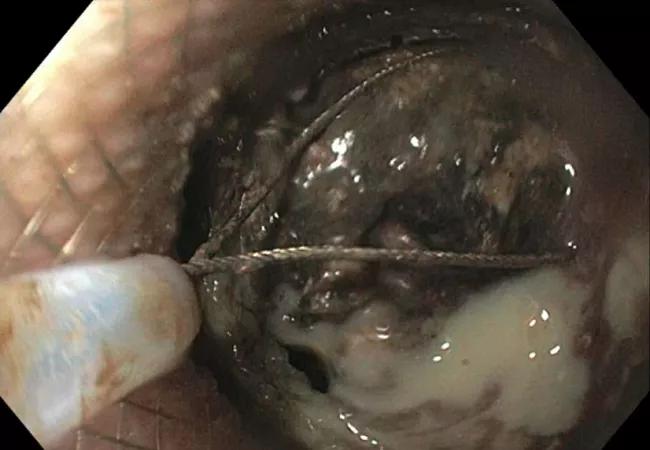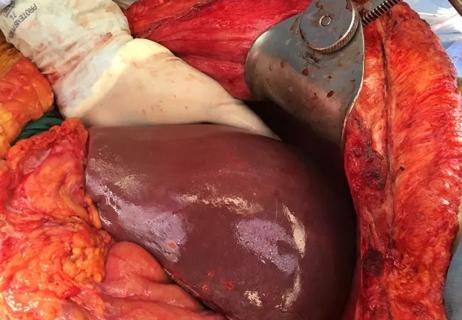Acute pancreatitis is associated with a significant morbidity rate of 1 to 5% and is among the most common gastrointestinal causes of inpatient hospitalization. Complications of pancreatic necrosis may be treated using several minimally-invasive surgical techniques.
Cleveland Clinic is a non-profit academic medical center. Advertising on our site helps support our mission. We do not endorse non-Cleveland Clinic products or services. Policy
In this Q&A with Consult QD, Prabhleen Chahal, MD, therapeutic endoscopist and Program Director of Advanced Endoscopy Fellowship in Cleveland Clinic’s Department of Gastroenterology, discusses her experience managing pancreatic necrosis using endoscopic pancreatic necrosectomy (EPN).
Dr. Chahal: Acute pancreatitis can lead to formation of a pseudocyst or walled-off necrosis. A pseudocyst is an encapsulated homogenous fluid collection, whereas a walled-off necrosis has both fluid and non-fluid solid components that represent dead pancreatic or fat tissue.
Dr. Chahal: We intervene upon a pseudocyst or walled-off necrosis only when there are significant symptoms present, such as persistent abdominal pain, infection or extrinsic compression of the stomach or small intestine. Fluid collections can cause a narrowing of the lumen, leading to the inability to eat, nausea and vomiting.
Dr. Chahal: There are several different types of minimally-invasive techniques to drain and debride the pseudocyst or infected pancreatic necrosis, including interventional radiology-guided percutaneous drainage, surgeon-led laparoscopy and retroperitoneal debridement.
Endoscopic pancreatic necrosectomy refers to the endoscopic drainage and debridement of pancreatic necrosis. The procedure has been performed for close to three decades but has evolved over time due to the availability of newer and larger-sized stents that facilitate access to the necrotic cavity from the stomach or duodenum for drainage and direct endoscopy-guided debridement of dead tissue.

This image shows a stent extending from the stomach into an infected, walled-off pancreatic necrotic region. A snare is used to remove necrotic tissue.
Dr. Chahal: Prior to endoscopic management, it is crucial to classify pancreatic fluid collections as either pseudocyst or walled-off pancreatic necrosis because of the differences in prognosis and treatment. Magnetic resonance imaging (MRI) and endoscopic ultrasound are the preferred tests for evaluating the necrotic debris, as computed tomography (CT) imaging can underestimate the presence of necrosis. The management has changed from what was historically a surgical intervention to less invasive approaches.
Dr. Chahal: Patients with walled-off pancreatic necrosis are sicker, with a higher risk of death from the underlying disease. If the necrosis is infected, the risk of death is as much as 20%, or 1 in 5. Endoscopic management of walled-off necrosis carries the risk of bleeding, perforation, stent migration and infection. The reported complication rate can be as high as 15 to 18%. Usually, patients with walled-off necrosis in close proximity to the stomach or duodenum are best suited for the endoscopic approach. Typically, these patients require one to three endoscopic procedures for complete debridement of necrosis, followed by a CT scan or MRI to confirm the resolution of the collection, then endoscopic stent removal.
Dr. Chahal: At Cleveland Clinic, we have been successfully managing walled-off pancreatic necrosis endoscopically, with a success rate of more than 85 percent. The remainder of our patients required either additional drainage in the form of percutaneous drainage tubes or minimally invasive surgery.
As described in the medical literature, some of the advantages of EPN over other techniques include shorter hospital length of stay and greater cost-effectiveness, with comparable safety and efficacy.

Addressing gender and diversity issues are among her priorities

The gastroenterologist's plans for the institute

What is an accountable care organization and how does it work?

Specialty care programs quickly expanding to meet the region’s needs

Incoming president Tracy Hull, MD, discusses her goals for the colorectal surgery society

Cleveland Clinic’s John Vargo, MD, MPH, on his leadership plans for the endoscopy society

Build the team and listen to its members, this gastroenterology leader advises

A Q&A with Drs. Hashimoto and Kwon